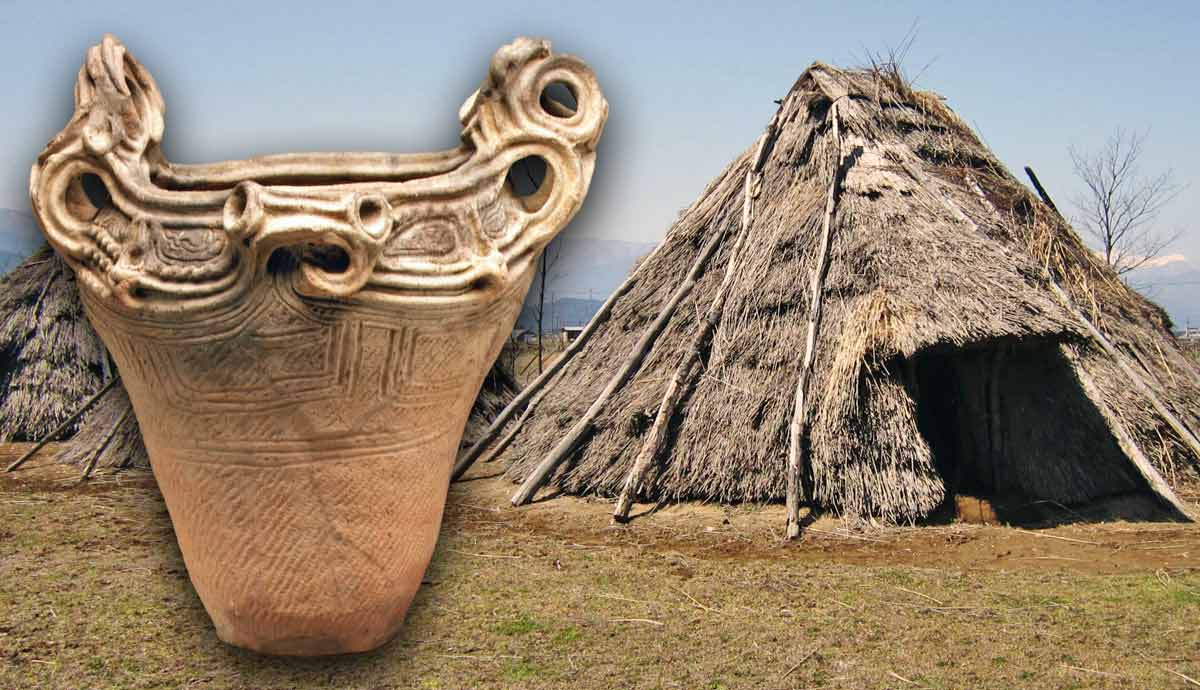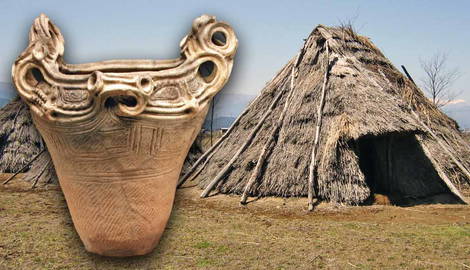
summary
- The Jōmon Period (at least 10,000 to 300 BCE) saw the first people migrate into Japan over land bridges during the last Ice Age.
- Early Jōmon people were hunter-gatherers, forced to adapt their diet from large game to plants and sea life as Japan became islands.
- Pottery became more intricate over time, with the Middle Jōmon period showing increased artistic exploration and sedentary life.
- The Late Jōmon saw complex dogū figurines and ritual tooth ablation, ending around 300 BCE with new migrations.
Long before the age of shoguns and samurai, before the Japanese people even arrived in what is now considered their homeland, the islands were already inhabited in what is known as the Jōmon period. While the people of the Jōmon period had no written language, archaeology reveals fascinating insights into their world.
Incipient Jōmon Period (10500-8000 BCE)

Around 39,000 years ago, before the rise of sedentary civilization, hunter-gatherers lived by following the herds of animals upon which they relied. During the Last Ice Age, lower sea levels meant that Japan’s islands were connected to mainland Asia, allowing people to follow these herds into Japan. Located on the Pacific Ring of Fire, Japan’s volcanic landscape had many of the resources early hunter-gatherers needed to make stone tools. Evidence suggests that these early inhabitants were mining obsidian as far back as 35,000 years ago.
When the Ice Age ended, the glaciers retreated to the north, melted, and the sea levels began to rise. By the end of the Last Ice Age, roughly 10,000 years ago, Japan was a series of islands, and those on them were cut off from the Asian mainland. The herds were similarly cut off and separated from their migration routes. They suffered and began to die off. The people on the islands had to change their lifestyle and began hunting smaller game, becoming knowledgeable and involved in the Japanese flora and fauna.
The glacial retreat also turned Japan into a lush wilderness where trees and plants flourished. Among this flora were nut-bearing trees such as beeches, buckeyes, oaks, and chestnuts, which provided an invaluable source of food for the people of these Incipient and Initial Jōmon periods.
Initial Jōmon Period (8000-5000 BCE)

The southern part of Kyushu is of prime importance to Jōmon archaeology. Theories suggest that people in East Asia turned to a lifestyle that relied more heavily on a plant-based diet, and discoveries near Kagoshima support this theory. The ruins of Tanegashima are among Japan’s oldest and exhibit the extensive practice of preparation and cooking of nuts, most notably chestnuts, which may have formed the basis of these people’s diet.
As an archipelago, the warmer climate also brought an abundance of sea life to the coastal waters, and much human activity began to center around the harvesting and consumption of this sea life. Large mounds of shells in the archaeological record are a testament to this.
Prehistoric life was governed by Japan’s seasonal climate. In late autumn and winter, the Jōmon hunted boar and deer. In the spring, they gathered wild greens and shellfish. In the summer, the calmer waters allowed them to venture out into the sea and fish, and in the autumn, attention turned to collecting the plentiful nuts and wild fruit that were available.
The Initial Jōmon period lasted until around 5000 BCE, when the population multiplied due to an abundance of food and resources made available by a period of warmer, more humid weather.
The Early Jōmon Period (5000-2500 BCE)

The emergence of pottery in Japan likely began during the Incipient Jōmon period over 10,000 years ago. Around 5000 BCE, pottery slowly became more intricate as a culture formed around the creation of earthenware. This marked the beginning of the Early Jōmon period and the end of the Initial Jōmon period.
Pottery at this time was simple and decorated with corded designs, which would become more intricate over the centuries. Limited agriculture was practiced as the culture transitioned from a hunter-gatherer society into a pastoralist one. Lacquer groves were tended, and crops were farmed on a small scale. These crops included bottle-gourd, adzuki beans, soybeans, hemp, and Perilla. There is also evidence to suggest that peaches were cultivated.
The Middle Jōmon Period (2500-1500 BCE)

The period from 3520 BCE to 2470 BCE is considered the Middle Jōmon period. It is marked by the end of the hunter-gatherer lifestyle and a move towards a more sedentary way of life. This may have been affected by a spike in temperatures. People at this time also seem to have expanded into the mountains, where it was cooler. Populations also remained in the fertile plains, near the rivers, and in the coastal areas where food was plentiful.
Communities became larger, and various parts of the hunter-gatherer lifestyle remained, despite the need to support themselves via agriculture. Deer, bear, rabbit, and duck were all hunted, and fishing continued. The shell mounds that began in earlier periods became significantly larger, and burials took place in these by-products of Jōmon society. Clay beads that served an ornamental function in the early Jōmon period became grave goods in the Middle Jōmon period.
Archaeologists have also discovered increased evidence of ritualistic practices, as attested to by the large numbers of female figurines carved from stone, as well as a significant amount of phallic imagery.

While the Early Jōmon period focused on creating objects more in line with function rather than form, the Middle Jōmon period is notable for increased artistic exploration, even to the detriment of the object’s function. This is most evident in the rise of ornamental pottery. Pottery decorations included animal forms, suggestive of totemic reverence. Clay figurines were also created with holes in their necks, presumably so they could be hung in the house where they would serve a spiritual function. While the quality of the pottery ornamentation increased significantly, what is noticeable is that the quality of the clay did not.

During the Middle Jōmon period, houses also became more complex, and the usual pit-floor dwellings started to include floors paved with stone. Walls and roofs were now separated as different parts of the building, and construction became more complex. Thatch and other reeds constituted the construction material of choice.
Late Jōmon Period (1500-300 BCE)

A striking feature of the Late Jōmon period is the array of complex dogū figurines that became common. They were highly stylized figures of humans and animals decorated with patterns. Although originating in the Middle Jōmon period, their usage grew throughout the Late Jōmon period.
Dogū figurines are theorized to have been representative of gods and used for sympathetic magic. This may have been used to absorb ailments and negative things affecting humans. Thereupon, the figurines were destroyed or discarded, as many dogū figurines were found in ancient trash heaps. Many figurines have been found with parts of their bodies purposely removed.
The Yayoi period, which began around 300 BCE, coincided with the mass migration of peoples from the Asian mainland. It marked an end to the manufacture and usage of Dogū figurines, indicating a change in belief systems.
Populations across Japan were, of course, not uniform. The pottery of the Tohoku region of northern Honshu and the southern Hokkaido region was notable for its elaborate decoration. In contrast to this culture, pottery in many parts of western Japan during the Late Jōmon period showed a more austere aesthetic.
The Late Jōmon period was also notable for the prevalent style of beadwork. Curved, comma-shaped beads called Magatama were popular.

Housing structures also evolved during the Late Jōmon period from rounded dwellings to square or rectangular houses. Packed mud floors were covered with rugs. Like the houses in the previous periods, they included indoor fire pits.
One particularly common trait of the Jōmon period, which continued through the Late Jōmon period and well into the Yayoi period (300 BCE), was the practice of ritual tooth ablation. Around 80% to 90% of all skulls found from this time exhibit the absence of teeth that have been intentionally removed, probably as a rite of passage.
From around 1500 BCE, the climate began to cool, and the population of Japan started to decrease. It is suggested that a decrease in resources led to the overall population decline. By 300 BCE, the Late Jōmon period is considered to have ended, while some historians and archaeologists push this date further back as far as 1000 BCE.
The end of the Late Jōmon period was marked by an influx of people from the Korean Peninsula who began mixing with the local Jōmon people. This event marks the beginning of the Yayoi period of Japanese history.
Jōmon Legacy

While many thousands of artifacts have been discovered relating to the Jōmon period, it still remains the most mysterious part of Japanese history. We know nothing of the language, and most of what we know about their culture and religion is speculative. But the Jōmon legacy has left its mark on modern Japan.
From a genetic perspective, the Jōmon people live on in the Yamato people, who constitute 98% of Japan’s current population. Research has shown that modern Yamato people carry 30% paternal Jōmon DNA, 15% maternal DNA, and 10% autosomal (non-sex-specific) DNA.
Modern interest in the Jōmon culture has also gained much traction over the past few decades. Jōmon patterns and designs have become frequent in Japanese fashion, as well as in other parts of Japanese culture, such as stationery and packaged food. Efforts have also been made to recreate Jōmon pottery using ancient techniques.

With the designs on Jōmon figurines being popular, there is speculation that the designs represented ancient tattoos, despite the stigma attached to tattoos in Japanese culture. Educational interest in the Jōmon period has also increased, and Jōmon exhibitions in museums draw large crowds.










